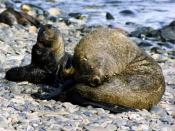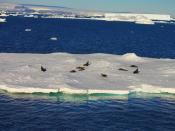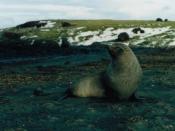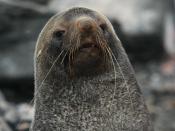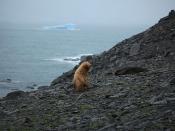There are 8 differnt speices of fur seals belonging to the otariid family one of these seals is known as the Antarctic Fur Seal. Antarctic Fur Seals were formerly known as the Kerguelen fur seal, but now their scientific name is Arctocephalus gazella These seals are also called 'eared seals' because of their small external ear-flaps. Some people also call them 'walking seals' because they can walk and run and move quickly, even over steep rocky surfaces.
These seals came close to extinction in the 19th centry because people hunted them for their velvety fur. Today fur seals can become entangled in marine debris such as polypropylene packaging bands, nylon string and fishing nets, but are no longer threatend for extinction. In 1982 there was an estimated 369,000 antarcitic fur seals on their breading grounds. Antarctic fur seals have more preditors then just humans. Leopard seals prey on some juveniles and pups, while killer whales may also be a predator.
Their fur is both waterproof and windproof, because of the dense velvety underpelt about 2.5 centimetres long. On the outside they have a thin layer of hairs. When the seals come out of the water they look very shinny as if they are covered with water, but with only a few shakes their fur is compleatly dry.
Because they are waterpoof and windproof this helps the seals to be equally fast on land and in water.
The seals live in on the beaches of many Sub Antarctic islands, but breed in only a few places mainly on Sub Antarctic islands south of the Antarctic convergence like South Georgia. About 95% of antarctic seals bread on the beaches of South Georgia. Other breading islands include the South Orkney and South Shetland Islands, South Sandwich Islands, Bouvetøya, Iles Kerguelen, and Heard Island, with only three colonies (on Marion Island, Iles Crozet, and Macquarie Island) lying north of the convergence.
The breeding season takes place from November to early January, the malearrive early at the sub-Antarctic islands in the middle of September to stake out territory and compete with each other for the breeding territory they pick as their own. Usually each male will end up with about 6 females after fighting for their territory.
Females give birth about 2 days after arriving at the rookery and the pups (baby seals) are normally born in November and December with a black fur coat.
Mother seals feed their pups for 2-3 months. This is much longer than other seals. In order to maintain their milk supply the mothers return to the sea during this feeding period. While away, the pups hide in sheltered areas, noisily barking when their mothers return. For the first 2-3 months the pups depend greatly on the cow seals for food and protection against preditors. A pup's normal weight at birth is anywhere between 3 and 7 kilograms.
The pup's fur moults 2-3 months after the pup is born and the they get a silvery-grey coat that eventually turns grey-brown and then a dark gingery color around their throat by the time they are an adult The females are called cows. They get up to about 1.5 meters (120 to 140cm) long and weigh about 50 kilograms. Cows usually can live for about 25 years. Adult cows and juveniles usually have a creamy color on the front of their throat, and some seals might have a creamy white color all around their throat.
The males are called bulls they get up to 2 meters (170 to 200 cm) long and weighabout 100 kilograms. The bulls have a mane with a few white hairs in it whichgives them more of a scary look. The bulls usually can live up to 15 years old. The main food of Antarctic fur seals is krill but fish, squid and even some birds are also eaten,especially outside the breeding season. Nursing mothers almost completely depend on krill. Some years there isn't alot of krill and this has a major affect on the breeding season of these seals. When a mother seal hunts for krill she dives 30 meters deep into the ocean, but if needed she can dive up to 100 meters deep.
